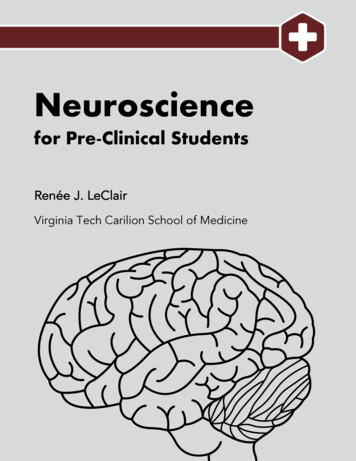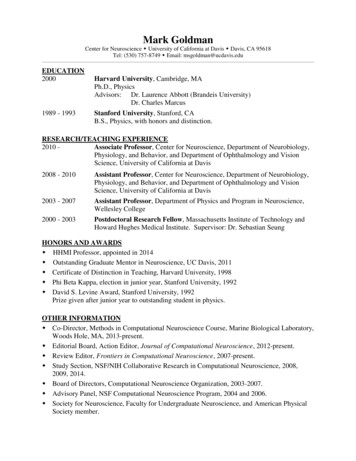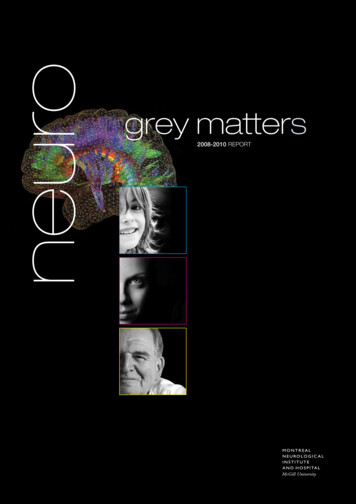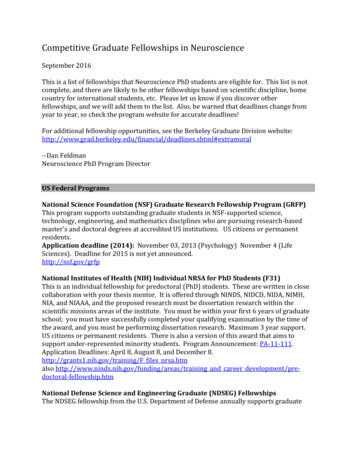
Transcription
Neurosciencefor Pre-Clinical StudentsRenée J. LeClairVirginia Tech Carilion School of Medicine
Neuroscience for Pre-Clinical Students covers neuroenergetics, neurotransmitters,neuropeptides, and selected amino acid metabolism and degradation. ThisUSMLE-aligned text is designed for a first-year undergraduate medical course andis meant to provide the essential biochemical information from these content areasin a concise format to enable students to engage in an active classroom. Hence, itdoes not cover neurophysiology and neuroanatomy; and clinical correlates andadditional application of content are intended to be provided in the classroomexperience. The text assumes that the students will have completed medical schoolprerequisites (including the MCAT) in which they will have been introduced to themost fundamental concepts of biology and chemistry that are essential tounderstand the content presented here. With its focus on high-yield concepts, thisresource will assist the learner later in medical school and for exam preparation.The 49-page text was created specifically for use by pre-clinical students at VirginiaTech Carilion School of Medicine and was based on faculty experience and peerreview to guide development and hone important topics.Licensed with a CreativeCommons AttributionNonCommercial-ShareAlike4.0 License.Cover design: Kindred GreyISBN: 978-1-949373-80-6DOI: https://doi.org/10.21061/neurosciencein association with
Neuroscience for Pre-Clinical Students
Neuroscience for Pre-Clinical StudentsRENÉE J. LECLAIRPDF AND EPUB FREE ONLINE AT: HTTPS://DOI.ORG/10.21061/NEUROSCIENCEVIRGINIA TECH CARILION SCHOOL OF MEDICINE IN ASSOCIATION WITH VIRGINIA TECH PUBLISHINGBLACKSBURG, VA
Neuroscience for Pre-Clinical Students by Renée J. LeClair is licensed under a Creative Commons Attribution-NonCommercial-ShareAlike 4.0International License, except where otherwise noted.You are free to copy, share, adapt, remix, transform, and build on the material for any primarily noncommercial purpose as long asyou follow the terms of the license: You must: Attribute – You must give appropriate credit, provide a link to the license, and indicate if changes were made. Youmay do so in any reasonable manner, but not in any way that suggests the licensor endorses you or your use. ShareAlike – If you remix, transform, or build on the material, you must distribute your contributions under thesame license as the original.You may not: NonCommercial – You may not use the work for primarily commercial use. Additional restrictions – You may not add any legal terms or technological measures that legally restrict othersfrom doing anything the license permits.Suggested citation: LeClair, Renée J. (2022) Neuroscience for Pre-Clinical Students. Blacksburg, VA: Virginia Tech Publishing.https://doi.org/10.21061/neuroscience. Licensed with CC BY-NC-SA 4.0 Publisher: This work is published by the Virginia Tech Carilion School of Medicine in association with Virginia Tech Publishing, adivision of the University Libraries at Virginia Tech.Virginia Tech Carilion School of Medicine2 Riverside CircleRoanoke, VA 24016 USAVirginia Tech PublishingUniversity Libraries at Virginia Tech560 Drillfield DriveBlacksburg, VA 24061 USAhttps://publishing.vt.edupublishing@vt.eduThis work is also distributed by LibreTexts, Davis, CA USA info@libretexts.orgNote: The LibreTexts version of this work at https://med.libretexts.org/@go/page/35685 may differ from this version.Peer review: This book has undergone single-blind peer review by two external reviewers.Accessibility statement: Virginia Tech Publishing is committed to making its publications accessible in accordance with theAmericans with Disabilities Act of 1990. The Pressbooks, PDF and ePub versions of this text are tagged structurally and includealternative text, which allows for machine readability.
Publication Cataloging Information:Renée LeClair, authorNeuroscience for Pre-Clinical StudentsPages cmISBN 978-1-949373-80-6 (PDF)ISBN 978-1-949373-81-3 (ePub)ISBN 978-1-949373-84-4 (Print)ISBN 978-1-949373-82-0 (Pressbooks) https://pressbooks.lib.vt.edu/neuroscienceURI (Universal Resource Identifier): http://hdl.handle.net/10919/105408DOI https://doi.org/10.21061/neuroscience1. Neurochemistry 2. Basic science 3. Medical educationI. TitleQP356.3 b .L43 2022Disclaimer: The information in this textbook is intended for educational purposes only and is not meant to take the place of medicalcare, diagnoses, or services. Please see your health care provider about any health concerns.Cover Art: Brain CC BY by Mahmure Alp from The Noun Project.Illustration and Cover Design: Kindred Grey
ContentsIntroductionviAcknowledgmentsviiiAbout the AuthorixInstructor Resourcesx1. Neuron and astrocyte metabolism12. Neurotransmitters — ACh, glutamate, GABA, and glycine93. Neuropeptides and unconventional neurotransmitters254. Amino acid metabolism and specialized products29
IntroductionNeuroscience for Pre-Clinical Students is designed to fill a gap in undergraduate medical education (UME) and supportpreclerkship education in the content area of biochemical neuroscience. Its content is aligned to USMLE(r) (UnitedStates Medical Licensing Examination) providing coverage of topics including: neuroenergetics, neurotransmitters,neuropeptides, and amino acid metabolism and heritable disorders of degradation. Unlike traditional textbooks, theorganization of this resource is driven by curricular structure, rather than subject area. As the format and designof UME differs across many programs, this resource is purposefully brief and flexible, allowing for rapid adaptationacross programs. The resource is organized into small chapters that can be used to support student preparation inany arrangement. The sections are not intended to be all-inclusive, but rather primers for applied content delivery.Similarly, clinical context is only briefly discussed allowing the user to apply the basic content (delivered here) in theclinical context used by their specific curricular structure. In our curriculum, these topic areas are interwoven intoproblem-based learning cases. The cases and clinical correlates change regularly and having the flexibility of these shortresources that can be applied to many scenarios across the first and second years of our curriculum is beneficial.Over the past twenty years, medical education has undergone a rapid curricular restructuring. This is in part due12to recommendations of the Flexner report, coupled with the changes observed in millennial and iGen learners. Toaccommodate the integration of additional core competencies, the majority of medical programs have moved away3from discipline-based delivery and currently use some form of integrated curricular format. This allows material to bepresented in a more clinically realistic and pertinent format without the constraints of artificial discipline silos. Thismovement has had positive impacts on programmatic outcomes and student performance, but it has presented somechallenges for curricular design, student engagement and educational resources.The creation of this resource was intended to address three predominant challenges in medical education: need, studentengagement and cost of textbooks. Although contemporary medical curricula have moved to a cohesive, integratedformat, the required textbooks for undergraduate medical education remain traditional and discipline-based. In theabsence of an integrated resource, students are requested to purchase and juggle preparation materials betweenmany different discipline-based textbooks. Traditional textbooks are often designed to support subject-based courses,rather than a clinically centered education. (Medical schools are educating future physicians, not future biochemists,physiologists, etc.) A high volume of content, some of it lacking alignment with class sessions coupled with restrictionson student contact time imposed by accrediting bodies, means that faculty across the country are having to rethinkpreparation materials to facilitate efficient, focused learning experiences.This resource is intended to provide learners with a high-level view of relevant topical areas that will be furtherelaborated on within the classroom setting. Unlike other traditional textbooks, it is not intended to include all content alearner would need about the relevant subject area but to function as a stepping stone towards mastery of the content.As programs embrace the philosophy of student-directed learning embedded in adult learning theory, more simplifiedreadily available resources will be essential to support this fast-paced learning of health professional educationalprograms. The short-divided nature of the resource makes it flexible and adaptable to many different curricular settingsas topic areas can be quickly divided or separated for ideal use. While there are many factors that can contribute toa student’s lack of preparation, lengthy textbook resources for a single integrated classroom session have a significantnegative impact. So while an integrated curricular model enhances many aspects of learning, it makes using traditionaltextbooks cumbersome and disjointed for students. This resource hopes to address this concern.Finally, there is a wealth of “medical” content freely accessible online, and students can find themselves spending asignificant amount of time trying to identify alternative resources that may—or may not—be appropriate. Faculty takingownership to identify and adapt realistic materials for each session reduces the concern that students are findingvi Introduction
misinformation through internet sources, and this project allows faculty to create a resource that harnesses the bestattributes of many different formats into a product that best supports the learning environment. Otherwise, externalonline resources are also likely to contain extraneous content that is not aligned with the classroom learning objectives(akin to subject-based textbook chapters), so it can also reduce the perceived worth of preparation. If the integratedresource is generated correctly, concisely and accurately by the faculty, the students will gain trust, rely on the vettedresources and prepare for the active classroom.— Renée LeClairNotes1.Cooke M, Irby DM, Ph D, et al. American Medical Education 100 Years after the Flexner Report. 2006:1339-1344.2.Roberts DH, Newman LR, Schwartzstein RM. Twelve tips for facilitating Millennials’ learning. Medical Teacher. 2012;34:274-278.3.VanTassel-Baska J, Wood S. The integrated curriculum model (ICM). Learning and Individual Differences. 2010;20(4):345-357.Introduction vii
AcknowledgmentsFunding and In-Kind SupportPublication of this work is made possible in part through the support of VIVA (Virtual Library of Virginia), LibreTexts, theOpen Education Initiative of the University Libraries at Virginia Tech, and Virginia Tech Publishing.Peer ReviewersLauren Kennedy-Metz, Instructor of Surgery, Harvard Medical SchoolKristofer Rau, Assistant Professor of Basic Science Education, Virginia Tech Carilion School of MedicineEditorial TeamManaging Editor: Anita WalzGraphic Design and Editorial Assistance: Kindred GreyAlternative Text: Sophia DeSimoneSpecial ThanksHenry Jakubowski, Emeritus, College of Saint Benedict and Saint John’s UniversityDelmar Larson, Founder, LibreTextsChrista Miller, Accessible Technologies, Virginia Techviii Acknowledgments
About the AuthorRenée J. LeClair is an Associate Professor in the Department of Basic Science Education at the Virginia Tech CarilionSchool of Medicine, where her role is to engage activities that support the departmental mission of developing anintegrated medical experience using evidence-based delivery grounded in the science of learning. She received aPh.D. at Rice University and completed a postdoctoral fellowship at the Maine Medical Center Research Institute invascular biology. She became involved in medical education, curricular renovation, and implementation of innovativeteaching methods during her first faculty appointment, at the University of New England, College of OsteopathicMedicine. In 2013, she moved to a new medical school, University of South Carolina, School of Medicine, Greenville. Theopportunities afforded by joining a new program and serving as the Chair of the Curriculum committee provided a blankslate for creative curricular development and close involvement with the accreditation process. During her tenure shedeveloped and directed a team-taught student-centered undergraduate medical course that integrated the scientificand clinical sciences to assess all six-core competencies of medical education.About the Author ix
Instructor ResourcesHow to Adopt This BookThis is an open textbook. That means that this book is freely available and you are welcome to use, adapt, and sharethis book with attribution according to the Creative Commons NonCommercial ShareAlike 4.0 (CC BY-NC-SA 4.0)license https://creativecommons.org/licenses/by-nc-sa/4.0. (This license does not apply to third-party works (images,illustrations, etc.)Instructors reviewing, adopting, or adapting this textbook are encouraged to register at https://bit.ly/interestpreclinical. This assists Virginia Tech’s Open Education Initiative in assessing the impact of the book and allows us tomore easily alert instructors of additional resources, features and opportunities.Finding Additional Resources for Your CourseThe main landing page for the book is http://hdl.handle.net/10919/105408.This page includes: Links to multiple electronic versions of the textbook (PDF, ePub, HTML) Links to the instructor resource-sharing portal Link to errata document https://pressbooks.lib.vt.edu/neuroscience Links to other books within this seriesSharing Resources You’ve CreatedHave you created any supplementary materials for use with Neuroscience for Pre-Clinical Students such aspresentation slides, activities, test items, or a question bank? If so, please consider sharing your materials relatedto this open textbook. Please tell us about resources you wish to share by using this form: https://bit.ly/interestpreclinical or by directly sharing resources under an open license to the public-facing instructor sharing al-resources/10133.Customizing This BookThe Creative Commons Attribution NonCommercial-ShareAlike 4.0 license legalcode on this book allows customization and redistribution which is NonCommercial, that is “notprimarily intended for or directed towards commercial advantage or monetary compensation.”Best practices for attribution are provided at https://wiki.creativecommons.org/wiki/ Best practices for attribution.This book is hosted in PDF and ePub in VTechWorks, in HTML in Pressbooks and via the LibreTexts platform. Pressbooksand LibreTexts platforms both offer customization/remixing.FeedbackTo report an error or omission, please use https://bit.ly/feedback-preclinical.We welcome additional feedback at publishing@vt.edu.x Instructor Resources
1. Neuron and astrocyte metabolismLearning Objectives Describe the metabolic pathway of glucose and its metabolites and how they are utilized in thebrain, and list the major energy-consuming processes in the brain. Describe the role of glial cells in neuron metabolism. Evaluate the interaction between astrocytes and neurons in the regulation of cerebral blood flow. Compare the metabolic profile of neurons and astrocytes. Review basic metabolic pathways, including: glycolysis, glycogen synthesis/olysis, transaminations, andglutathione synthesis.The adult brain consumes about 25 percent of the glucose-derived energy and 20 percent of oxygen is dedicated tocerebral functions. The primary fuel to support the high energy demands of this tissue is supplied in the form of glucose,however, not all neuronal tissues oxidize glucose to the same extent. This section will address the distinct metabolicdifferences between astrocyte and neuronal metabolic profiles and how this interplay is essential for brain metabolichomeostasis.As a brief review, glucose is taken up by the brain in an insulin-independent manner. The brain oxidizes glucose undermost conditions with the exception of starvation states. Once the glucose is phosphorylated to glucose 6-phosphate (byhexokinase), it has three potential fates (figure 1.1):1. Glycolysis (either leading to lactate production or mitochondrial metabolism),2. Pentose phosphate pathway (PPP), or3. Glycogen synthesis (only in astrocytes).Neuron and astrocyte metabolism 1
Figure 1.1: Potential fates of glucose oxidation. i. Glucose is oxidized to lactate; ii. Glucose is oxidized through the pentose phosphatepathway (PPP); iii. Glucose is stored as glycogen, which only occurs in astrocytes; iv. Pyruvate can be oxidized through the mitochondriabut is not a primary fate. (GLUTs: glucose transporters; MCTs: monocarboxylate transporters; TCA: tricarboxylic acid; DHAP:dihydroxyacetone phosphate; GA3P: glyceraldehyde 3-phosphate)What is unique to the brain is that not all cell types oxidize glucose to the same extent, but there is a tight couplingthat exists between cell types to support both energy demand and glutamate-mediated neurotransmission. Thiscompartmentalized, coupled metabolism between neurons and astrocytes is essential for ATP production, neuronalexcitability, and adaptations to stress.NoteIn the context of this chapter, oxidative metabolism refers to the oxidation of a substrate (glucose) throughmitochondrial metabolism versus glycolytic metabolism, which refers to the oxidation of glucose to lactate.2 Neuron and astrocyte metabolism
Neuron metabolismTo support the high energy demands imposed on neurons, they sustain a high rate of oxidative metabolism for ATPproduction compared to astrocytes. Despite this high rate of mitochondrial metabolism, glucose uptake is reducedwhen compared to astrocytes, in part due to the use of lactate as an energy source. Neurons show a preference forlactate over glucose when both substrates are present. There are several reasons why sustaining a low glycolytic ratebut high oxidative rate is preferred in this tissue:1. The bifunctional enzyme phosphofructokinase 2 (PFK2) is virtually absent in neurons, due to its constantproteasomal degradation. This enzyme is responsible for the generation of fructose 2,6-bisphosphate, which is anallosteric activator of the glycolytic enzyme phosphofructokinase 1 (PFK1).2. Elevated glycolytic flux impairs metabolism through the PPP. Neurons purposefully reduce glycolytic flux tomaintain metabolism through the PPP—which is essential for the production of NADPH through the reactioncatalyzed by glucose 6-phosphate dehydrogenase.To accommodate these two processes, neurons preferentially utilize lactate, which can be readily converted to pyruvateand enter the mitochondria (figure 1.2). The lactate required for neuronal metabolism is produced by astrocytic glucoseoxidation and is discussed below.Figure 1.2: Comparison of neuron and astrocyte metabolism. (PDH: pyruvate dehydrogenase complex; PKM1/2: pyruvate kinase isoformsM1 and M2; TCA: tricarboxylic acid; DHAP: dihydroxyacetone phosphate; GA3P: glyceraldehyde 3-phosphate)Neuron and astrocyte metabolism 3
Astrocyte metabolismWithin the brain, astrocytes outnumber neurons but have reduced demand for ATP. Although astrocytes display loweroxidative rates when compared to neurons, they have elevated glycolytic rates and avidly take up glucose to supportthis. Astrocytes primarily metabolize glucose to lactate (rather than through mitochondrial metabolism) and releasethe lactate in the extracellular space. Astrocytes support this glycolytic profile through the alteration of several keyglycolytic enzymes.1. Astrocytes have increased expression of PFK2, which assists with the elevated glycolytic rate via the allostericactivation of PFK1 by fructose 2,6-bisphosphate.2. Astrocytes have reduced expression of the aspartate/glutamate carrier (AGC), a component of the malateaspartate shuttle, which facilitates the transfer of reducing equivalents from the cytosol to the mitochondria. As a result, the conversion of pyruvate to lactate in the cytosol is needed to maintain a high NAD /NADH ratio, which isessential to sustain a high glycolytic rate.3. Finally, the conversion of pyruvate to lactate in astrocytes is also favored by both reduced expression andphosphorylation-mediated inactivation of the pyruvate dehydrogenase complex (figure 1.2).Astrocyte-mediated neurotransmitter recyclingTo terminate synaptic transmission and maintain neuronal excitability, astrocytes play a key role in the rapid removalof neurotransmitters from the synaptic cleft. The removal of glutamate is specifically critical as this is the primaryexcitatory neurotransmitter, and overstimulation of glutamate receptors is highly toxic to neurons.Astrocytes recycle glutamate through sodium-dependent high-affinity glutamate transporters. Following glutamateuptake, astrocytes also play an important role in transferring this neurotransmitter back to neurons. This transferis achieved by a process called the glutamate-glutamine cycle, which involves both glutamine synthetase (GS) andglutaminase (GLS) (figure 1.3).1. First, glutamate is converted to glutamine by the astrocyte-specific enzyme GS.2. Glutamine is then transferred to neurons and converted back to glutamate via deamination by GLS.It is also important to note that astrocytes are the only neural cell type expressing pyruvate carboxylase, a key enzymein the main anaplerotic pathway in the brain. This allows astrocytes to effectively synthesize glutamate from glucose,making them the cell type responsible for the replenishment of brain glutamate.4 Neuron and astrocyte metabolism
Figure 1.3: Lactate and glutamate shuttling between the astrocyte and the neuron. (GS: glutamine synthetase; GLS: glutaminase; LDH:lactate dehydrogenase; EAATs: excitatory amino acid transporters; MCT: monocarboxylate transporter; GluR: glutamate receptor).Astrocyte-neuron lactate shuttleTo this point, we have addressed the need for lactate in the neuron to sustain high demands for ATP, astrocyte glycolyticactivity and elevated glucose uptake, and the role of the astrocyte in glutamate recycling. These three processes are notunrelated, and the juxtaposition in energy needs and glucose uptake between these two cell types can be reconciledwhen we address the role of the astrocyte-neuron lactate shuttle (ANLS).The premise of this shuttle is threefold:1. Neuronal activity increases extracellular glutamate (via glutamatergic neurotransmission), which is avidly taken up via an Na -dependent mechanism. 2. The resulting increase in intracellular Na activates the Na /K ATP-ase and increases ATP consumption.3. The fall of ATP increases lactate production, which is released into the extracellular space.Finally, lactate can be used as an energy substrate for neurons for oxidative-derived ATP production (figure 1.3).Neuron and astrocyte metabolism 5
Astrocyte glycogen storesGlycogen is the largest energy reserve of the brain and provides a source of glucose that can be rapidly mobilizedwithout ATP. Stores of glycogen in the brain are almost exclusively localized to astrocytes. Again, this observation raisesthe question as to why the main energy reserve in the brain is found in astrocytes rather than the high-energy-requiringneurons.Much like the lactate shuttle, glycogen metabolism relies heavily on the interaction between the two cell typesto preserve metabolic homeostasis within the brain environment. Glycogen mobilization can support astrocytemetabolism, but it also increases lactate production and the concentration of lactate in the extracellular space.Considering the role of astrocytic glucose-derived lactate in fueling neuronal energy needs, this coupling of thesecompartmentalized metabolic processes helps preserve the function of each cell type.Glycogen also has other roles in the normal brain. The amount of glycogen is under dynamic control ofneurotransmitters. For example, decreased neuronal activity, such as in sleep, correlates with increased levels of brainglycogen, while an increase in neuronal activity, such as in the awake brain, is associated with a decrease in glycogenlevels in active areas.As a whole, these observations demonstrate that astrocytic glycogen plays an important and active role in complexbrain physiological functions, in particular through an astrocyte-to-neuron transfer of energy metabolites in the formof lactate.The role of astrocyte-neuron interactions to reduce oxidative stressOxidative injury is a key feature of several neuropathological conditions such as stroke, traumatic brain injury, andneurodegenerative diseases. There are several factors that contribute to increased brain vulnerability to oxidative stress,including its high rate of oxidative energy metabolism (a process inevitably generating reactive oxygen species (ROS) asa byproduct), its high unsaturated fatty acids content (which are prone to lipid peroxidation), and its relatively lowintrinsic antioxidant capacity.Although neurons have a higher proportion of oxidative metabolism, they have few defenses against oxidative stress.Astrocytes, alternatively, have significant levels of ROS-detoxifying enzymes, including glutathione, heme oxygenase 1,glutathione peroxidase, glutathione S-transferase, catalase, and thioredoxin reductase. As a result, astrocytes are muchmore resistant to cellular damage by H2O2, NO, peroxinitrites, and 6-hydroxydopamine compared to neurons.Astrocytes also play an important protective role for neurons, suggesting that neurons are dependent on the highantioxidant potential of astrocytes for their own defense against oxidative stress.One way in which astrocytes provide protection is through the shuttling of glutathione (GSH) precursors fromastrocytes to neurons. GSH—the most abundant antioxidant molecule in the brain—either acts directly as a ROSscavenger or can be used as a substrate for glutathione S-transferase or glutathione peroxidase. Both cell types cansynthesize the GSH tripeptide, but neurons are highly dependent on astrocytes for the supply of the precursor aminoacids necessary for their own GSH synthesis.The reduction of peroxides catalyzed by glutathione peroxidase generates glutathione disulfide (GSSG, the oxidizedform of GSH). GSH can subsequently be regenerated from GSSG by the action of the enzyme glutathione reductase,using NADPH as an electron donor. This process is essential for the maintenance of GSH in its reduced form, and thus for6 Neuron and astrocyte metabolism
its availability for the detoxification of ROS. As a consequence, constant NADPH supply is essential for the maintenanceof the cellular redox state.NADPH production is mainly achieved by the metabolism of glucose via the PPP, thereby coupling glutathione recyclingto glucose utilization. NADPH is more abundant in astrocytes than in neurons, and astrocytes have a higher basal PPPactivity rate and a better capacity to stimulate this pathway in response to oxidative stress.Astrocyte-neuron impact on cerebral blood flowThe metabolic interplay between astrocytes and neurons goes beyond substrate usage and availabilityto impact cerebral blood flow through both vasoconstriction and vasodilation. Interestingly, these opposite effects onthe vascular tone involve different but parallel signaling cascades in astrocytes.Briefly, neuronal release of glutamate can stimulate the metabotropic glutamate receptors (mGluR) on astrocytes. Thisin turn activates phospholipase C and increases intracellular calcium. Ca2 transients in astrocytes activate cytosolicphospholipase A2 (PLA2), thus producing arachidonic acid (AA). AA can be used for the synthesis of prostaglandins,which can have different types of vasodilating effects. In parallel, AA can diffuse to arteriolar smooth muscle cells,where it is converted to 20-hydroxyeicosatetraenoic acid (20-HETE), which has a vasoconstricting effect. Whetherthe predominant impact on vascular tone is dilation or constriction depends on levels of lactate and adenosine in theextracellular space.During brain activation, consistent with low O2, an increase in lactate in the extracellular space will enhance vasodilationby assisting in the accumulation of prostaglandin E2 (PGE2). Elevated adenosine also enhances vasodilation but throughan inhibitory effect on the synthesis of 20-HETE. This is an interesting observation and suggests that cerebral bloodflow is largely controlled by glycolytic (vs. oxidative) metabolism and that increased cerebral blood flow correlates withelevations in lactate concentration (rather than O2 consumption).References and resourcesTextBélanger, M., I. Allaman, and P. J. Magistretti. “Brain Energy Metabolism: Focus on Astrocyte–NeuronMetabolic Cooperation.” Cell Metabolism 14, no. 6 (December 2011): 724–738, https://doi.org/10.1016/j.cmet.2011.08.016.Le, T., and V. Bhushan. First Aid for the USMLE Step 1, 29th ed. New York: McGraw Hill Education, 2018, 87,314–315.Lieberman, M., and A. Peet, eds. Marks’ Basic Medical Biochemistry: A Clinical Approach, 5th ed. Philadelphia:Wolters Kluwer Health/Lippincott Williams & Wilkins, 2018, Chapter 46: Metabolism of the Nervous System.Magistretti, P. J., and I. Allaman. “A Cellular Perspective on Brain Energy Metabolism and FunctionalImaging.” Neuron 86, no. 4 (May 2015): 883–901, n and astrocyte metabolism 7
FiguresFigure 1.1: Potential fates of glucose oxidation. Magistretti, P. J., and I. Allaman. “A Cellular Perspective onBrain Energy M
Tech Carilion School of Medicine and was based on faculty experience and peer review to guide development and hone important topics. . Neuroscience for Pre-Clinical Students by Renée J. LeClair is licensed under a Creative Commons Attribution-NonCommercial-ShareAlike 4.0 . Harvard Medical School Kristofer Rau, Assistant Professor of Basic .










